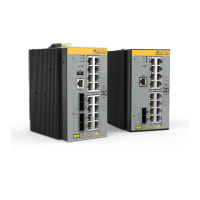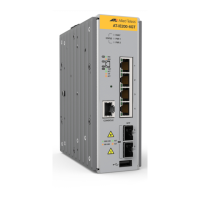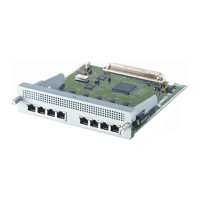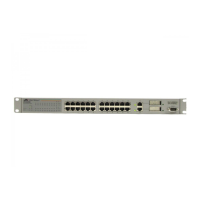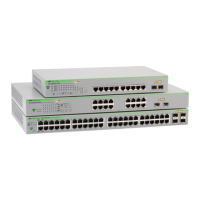C613-50631-01 Rev A Command Reference for IE340 Series 2677
AlliedWare Plus™ Operating System - Version 5.5.3-0.x
ETHERNET PROTECTION SWITCHED RING (EPSRING™) COMMANDS
EPSR
FLUSH-TYPE
epsr flush-type
Overview Use this command to set how EPSR flushes Layer 2 entries when a topology change
occurs. It can be configured to flush all Layer 2 entries on its EPSR interfaces or only
flush the Layer 2 entries on its EPSR data VLANs.
Use the no variant of this command to revert to the default setting.
Syntax
epsr <epsr-name> flush-type {interface|vlan}
no epsr <epsr-name> flush-type
Default The default flush-type is vlan
Mode EPSR Configuration
Usage notes To flush all entries on the EPSR interface (including non-EPSR data VLANs) the
flush-type command must be explicitly configured on the EPSR ring with the
interface parameter.
Select interface as the flush-type to help reduce latency caused during EPSR
topology changes. This type of flushing is quicker and less granular than flushing
per data vlan, as flushing on a data vlan may incur a higher overhead, reducing
EPSR responsiveness to ring topology changes.
Interface flushing can be used to optimize EPSR rings with a large number of
VLANs. It will however also require relearning on any VLANs that are on an EPSR
interface but not part of the EPSR configuration.
Example To configure the behavior of EPSR ring ‘red’ transit node on topology changes to
flush all Layer 2 entries on its EPSR ring interfaces, use the following commands:
awplus# configure terminal
awplus(config)# epsr configuration
awplus(config-epsr)# epsr red mode transit controlvlan 10
awplus(config-epsr)# epsr red datavlan 20-29
awplus(config-epsr)# epsr red flush-type interface
awplus(config-epsr)# epsr red state enable
Related
commands
show epsr
Parameter Description
<epsr-name> The name of the EPSR instance to set the flush-type for.
interface Flush all Layer 2 entries from the EPSR interface on a topology
change.
vlan Flush the Layer 2 entries on the EPSR interface and data VLANs on a
topology change.

